[/caption]
While mission specialists John Grunsfeld and Drew Feustel successfully accomplished all their tasks for the first EVA of the Hubble servicing mission, it didn’t come without a little drama. A stubborn bolt threatened to thwart one of the spacewalk’s main goals, replacing the venerable space telescope’s workhorse optical camera with a new and improved instrument. But after a fair amount of old fashioned elbow grease, the Wide Field Planetary Camera 2 was able to be removed. The camera was originally installed in the first Hubble servicing mission in 1993, and was nicknamed “the camera that saved Hubble” because its special optics were able to overcome the spherical aberration in the telescope’s main mirror.
The astronauts also replaced Hubble’s data handling computer – the system that relays data to Earth which gave out last September, delaying this servicing mission, (scheduled to launch last October) until a replacement would be ready.
Watch HD video taken by the shuttle astronauts of Thursday’s activities.
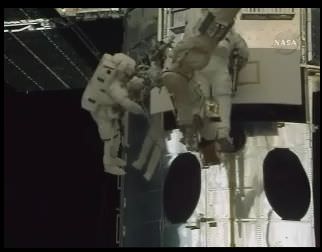
Strapped onto the shuttle’s robotic arm, Feustel struggled with a bolt on the old WFPC2 camera for more than an hour. “It’s been in there for 16 years — and it didn’t want to come out,” Grunsfeld said.
Feustel and Grunsfeld worried the bolt might snap, but Mission Control gave Feustel the go-ahead to disable the torque setting on his pistol grip tool.
“We understand if it breaks, then Wide Field (Planetary Camera 2) stays in,” Grunsfeld verified with Mission Control, before Feustel’s high stakes attempt.
“What John said is correct,” capcom Dan Burbank confirmed.
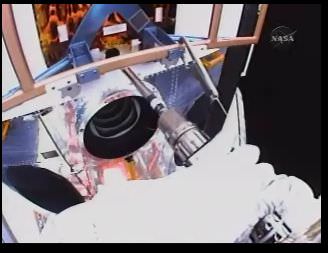
Feustel cranked with all his might, and finally it turned.
“I think I got it — It turned, it definitely turned. And it’s turning easily now. Woo hoo, it’s moving out” Feustel said jubilantly.
Once the bolt was freed, Feustel pulled out the old camera, which is about the size of a piano.
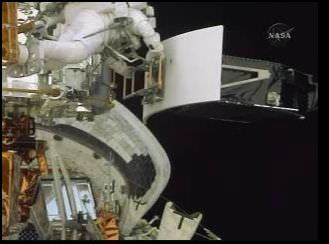
Installing the new $132 million WFPC3 was among the highest priorities for the mission, and will allow Hubble to capture images in infrared, ultraviolet and visible wavelengths of objects from as early as 500 million years after the birth of the universe.
Grunsfeld and Feustel also attached a docking mechanism on Hubble so a robotic spacecraft can attach itself to the telescope when its mission is over and maneuver it through a commanded descent through Earth’s atmosphere to its final resting place in the Pacific Ocean. They also lubricated some of Hubble’s doors and tried to install door mechanisms, which also gave them some trouble.
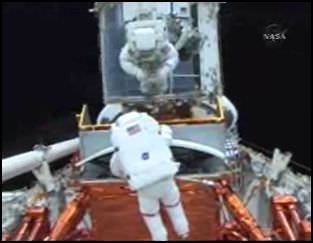
After installation of WFPC2 and the new data handling system, the Space Telescope Operations Center tested the connections and communications with the instruments, and was able to report to the crew on orbit that both systems passed initial “aliveness” tests.
The 11-day mission is NASA’s fifth and final repair mission to Hubble, with five consecutive spacewalks scheduled. This is NASA’s last chance to service the telescope the end of the shuttle program in 2010. NASA hopes the improvements will keep Hubble operational until at least 2014.
On Friday, two different spacewalkers will replace Hubble’s old and suspect gyroscopes and a set of aging batteries in order to extend the space telescope’s lifetime through at least 2014. Watch NASA TV online to see the EVA, or follow me on Twitter – I’ll be tweeting the highlights of the spacewalk.

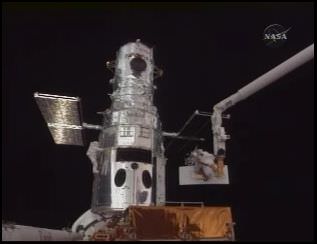
There were a lot of astronomers holding their breath while they were wrestling with that recalcitrant bolt. The WFPC3 has been under development for the best part of a decade, so you can imagine how they must have been feeling as they watched the crew working their way down to the bottom of the list of contingency actions — and they did reach the very bottom. If the bolt had threaded, that would have been game over—a hundred million dollar project foiled by a single bolt!
They only got two out of the three door latches installed (there was another pesky bolt interfering with the third (middle) latch. They eventually decided that the middle latch would risk prizing open the door too much and leaking light inside, so they installed a “latch repair mechanism” over the bolt instead. From what I understand, the latches are just a convenience anyway, aimed at speeding up the 3rd day’s spacewalk, so failing to install one of them won’t hold up things by more than a few minutes.
All in all, it was a good day. Both the WFPC3 camera and the computer system they replace passed “liveness” tests to show that they were up and running, and I believe all the functional tests they’ve run so far have passed.
Finally, at the press conference they said that they were aiming to get “first light” photos from WFPC3 sometime in early September, though they would not be held to that as a promise!
A very cool day for astronomy all round.
While watching the WFC 3 install, I kept thinking ‘something old, something new’ . The old: part of this instrument has already flown, as the enclosure components used are from the original WFPC that was returned when WFPC 2 was installed. In an article on the WFC 3, it was noted ” The Wide Field Camera 3’s housing, radiator and other components came from the original WFPC which returned to Earth at the conclusion of the first Hubble servicing mission.” The new: Integrated circuit chips designed for the James Webb Space Telescope (JWST) were installed in the data handling computer on Hubble. So at least a small part of JWST is already up there ! Each chip can replace an entire circuit board on Hubble, so it’s great to see this new technology serve to extend Hubble’s life. A very cool day for astronomy indeed !
I was glad to hear that the WFPC2 will find a permanent home at the Air & Space Museum in Washington, with a stint at JPL beforehand. I heard at the press conference about a possible short display at the museum (with a couple of the astronauts on this mission on hand, at that! ) right around that WFC 3 ‘first light’ image around the beginning of September. Mention of a possible travelling exhibit of the camera is also being looked at , which would be great ( I’m near a science museum in Tampa, FL ).
New camera…..looking forward to new crisper images of Mars. The pix so far of Mars are barely better than those taken by Slipher in the first half of the last century. If Hubble looks a few months before or after opposition, we might get a glimpse of the global scale shadowing of features that suggested “canals” in the minds of many early astronomers. And seasonal color/shade change – there still doesn’t exist a good color sequence of that, after all this time. (I’m sure we could spare a few seconds from taking deep space images).
God it would have been awful if we wouldn’t have been able to install WFPC3 just because of one… stupid… bolt.
I guess WD40 would be hard to work with in space!
Congrats!
[But tell me again why STS needs to be replaced instead of improved. Sob!]